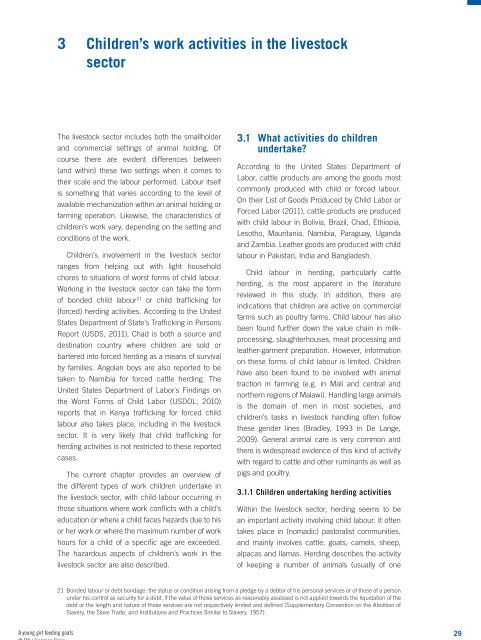Children’s work in the livestock sector: Herding and beyond
Children’s work in the livestock sector: Herding and beyond
Children’s work in the livestock sector: Herding and beyond
You also want an ePaper? Increase the reach of your titles
YUMPU automatically turns print PDFs into web optimized ePapers that Google loves.
A young girl feed<strong>in</strong>g goats<br />
3 <strong>Children’s</strong> <strong>work</strong> activities <strong>in</strong> <strong>the</strong> <strong>livestock</strong><br />
<strong>sector</strong><br />
The <strong>livestock</strong> <strong>sector</strong> <strong>in</strong>cludes both <strong>the</strong> smallholder<br />
<strong>and</strong> commercial sett<strong>in</strong>gs of animal hold<strong>in</strong>g. Of<br />
course <strong>the</strong>re are evident differences between<br />
(<strong>and</strong> with<strong>in</strong>) <strong>the</strong>se two sett<strong>in</strong>gs when it comes to<br />
<strong>the</strong>ir scale <strong>and</strong> <strong>the</strong> labour performed. Labour itself<br />
is someth<strong>in</strong>g that varies accord<strong>in</strong>g to <strong>the</strong> level of<br />
available mechanization with<strong>in</strong> an animal hold<strong>in</strong>g or<br />
farm<strong>in</strong>g operation. Likewise, <strong>the</strong> characteristics of<br />
children’s <strong>work</strong> vary, depend<strong>in</strong>g on <strong>the</strong> sett<strong>in</strong>g <strong>and</strong><br />
conditions of <strong>the</strong> <strong>work</strong>.<br />
<strong>Children’s</strong> <strong>in</strong>volvement <strong>in</strong> <strong>the</strong> <strong>livestock</strong> <strong>sector</strong><br />
ranges from help<strong>in</strong>g out with light household<br />
chores to situations of worst forms of child labour.<br />
Work<strong>in</strong>g <strong>in</strong> <strong>the</strong> <strong>livestock</strong> <strong>sector</strong> can take <strong>the</strong> form<br />
of bonded child labour21 or child traffick<strong>in</strong>g for<br />
(forced) herd<strong>in</strong>g activities. Accord<strong>in</strong>g to <strong>the</strong> United<br />
States Department of State’s Traffick<strong>in</strong>g <strong>in</strong> Persons<br />
Report (USDS, 2011), Chad is both a source <strong>and</strong><br />
dest<strong>in</strong>ation country where children are sold or<br />
bartered <strong>in</strong>to forced herd<strong>in</strong>g as a means of survival<br />
by families. Angolan boys are also reported to be<br />
taken to Namibia for forced cattle herd<strong>in</strong>g. The<br />
United States Department of Labor´s F<strong>in</strong>d<strong>in</strong>gs on<br />
<strong>the</strong> Worst Forms of Child Labor (USDOL, 2010)<br />
reports that <strong>in</strong> Kenya traffick<strong>in</strong>g for forced child<br />
labour also takes place, <strong>in</strong>clud<strong>in</strong>g <strong>in</strong> <strong>the</strong> <strong>livestock</strong><br />
<strong>sector</strong>. It is very likely that child traffick<strong>in</strong>g for<br />
herd<strong>in</strong>g activities is not restricted to <strong>the</strong>se reported<br />
cases.<br />
The current chapter provides an overview of<br />
<strong>the</strong> different types of <strong>work</strong> children undertake <strong>in</strong><br />
<strong>the</strong> <strong>livestock</strong> <strong>sector</strong>, with child labour occurr<strong>in</strong>g <strong>in</strong><br />
those situations where <strong>work</strong> conflicts with a child’s<br />
education or where a child faces hazards due to his<br />
or her <strong>work</strong> or where <strong>the</strong> maximum number of <strong>work</strong><br />
hours for a child of a specific age are exceeded.<br />
The hazardous aspects of children´s <strong>work</strong> <strong>in</strong> <strong>the</strong><br />
<strong>livestock</strong> <strong>sector</strong> are also described.<br />
3.1 What activities do children<br />
undertake?<br />
Accord<strong>in</strong>g to <strong>the</strong> United States Department of<br />
Labor, cattle products are among <strong>the</strong> goods most<br />
commonly produced with child or forced labour.<br />
On <strong>the</strong>ir List of Goods Produced by Child Labor or<br />
Forced Labor (2011), cattle products are produced<br />
with child labour <strong>in</strong> Bolivia, Brazil, Chad, Ethiopia,<br />
Lesotho, Mauritania, Namibia, Paraguay, Ug<strong>and</strong>a<br />
<strong>and</strong> Zambia. Lea<strong>the</strong>r goods are produced with child<br />
labour <strong>in</strong> Pakistan, India <strong>and</strong> Bangladesh.<br />
Child labour <strong>in</strong> herd<strong>in</strong>g, particularly cattle<br />
herd<strong>in</strong>g, is <strong>the</strong> most apparent <strong>in</strong> <strong>the</strong> literature<br />
reviewed <strong>in</strong> this study. In addition, <strong>the</strong>re are<br />
<strong>in</strong>dications that children are active on commercial<br />
farms such as poultry farms. Child labour has also<br />
been found fur<strong>the</strong>r down <strong>the</strong> value cha<strong>in</strong> <strong>in</strong> milkprocess<strong>in</strong>g,<br />
slaughterhouses, meat process<strong>in</strong>g <strong>and</strong><br />
lea<strong>the</strong>r-garment preparation. However, <strong>in</strong>formation<br />
on <strong>the</strong>se forms of child labour is limited. Children<br />
have also been found to be <strong>in</strong>volved with animal<br />
traction <strong>in</strong> farm<strong>in</strong>g (e.g. <strong>in</strong> Mali <strong>and</strong> central <strong>and</strong><br />
nor<strong>the</strong>rn regions of Malawi). H<strong>and</strong>l<strong>in</strong>g large animals<br />
is <strong>the</strong> doma<strong>in</strong> of men <strong>in</strong> most societies, <strong>and</strong><br />
children’s tasks <strong>in</strong> <strong>livestock</strong> h<strong>and</strong>l<strong>in</strong>g often follow<br />
<strong>the</strong>se gender l<strong>in</strong>es (Bradley, 1993 <strong>in</strong> De Lange,<br />
2009). General animal care is very common <strong>and</strong><br />
<strong>the</strong>re is widespread evidence of this k<strong>in</strong>d of activity<br />
with regard to cattle <strong>and</strong> o<strong>the</strong>r rum<strong>in</strong>ants as well as<br />
pigs <strong>and</strong> poultry.<br />
3.1.1 Children undertak<strong>in</strong>g herd<strong>in</strong>g activities<br />
With<strong>in</strong> <strong>the</strong> <strong>livestock</strong> <strong>sector</strong>, herd<strong>in</strong>g seems to be<br />
an important activity <strong>in</strong>volv<strong>in</strong>g child labour. It often<br />
takes place <strong>in</strong> (nomadic) pastoralist communities,<br />
<strong>and</strong> ma<strong>in</strong>ly <strong>in</strong>volves cattle, goats, camels, sheep,<br />
alpacas <strong>and</strong> llamas. Herd<strong>in</strong>g describes <strong>the</strong> activity<br />
of keep<strong>in</strong>g a number of animals (usually of one<br />
21 Bonded labour or debt bondage: <strong>the</strong> status or condition aris<strong>in</strong>g from a pledge by a debtor of his personal services or of those of a person<br />
under his control as security for a debt, if <strong>the</strong> value of those services as reasonably assessed is not applied towards <strong>the</strong> liquidation of <strong>the</strong><br />
debt or <strong>the</strong> length <strong>and</strong> nature of those services are not respectively limited <strong>and</strong> def<strong>in</strong>ed (Supplementary Convention on <strong>the</strong> Abolition of<br />
Slavery, <strong>the</strong> Slave Trade, <strong>and</strong> Institutions <strong>and</strong> Practices Similar to Slavery, 1957).<br />
29


